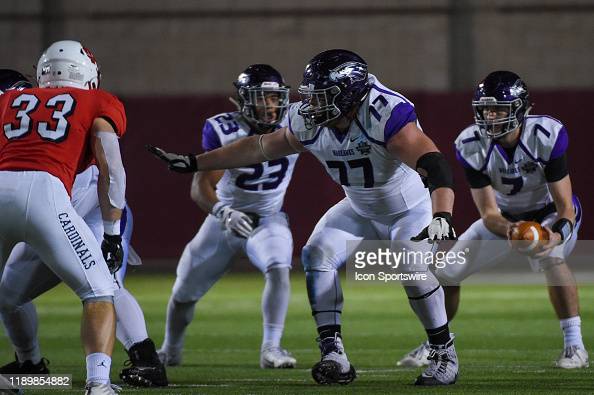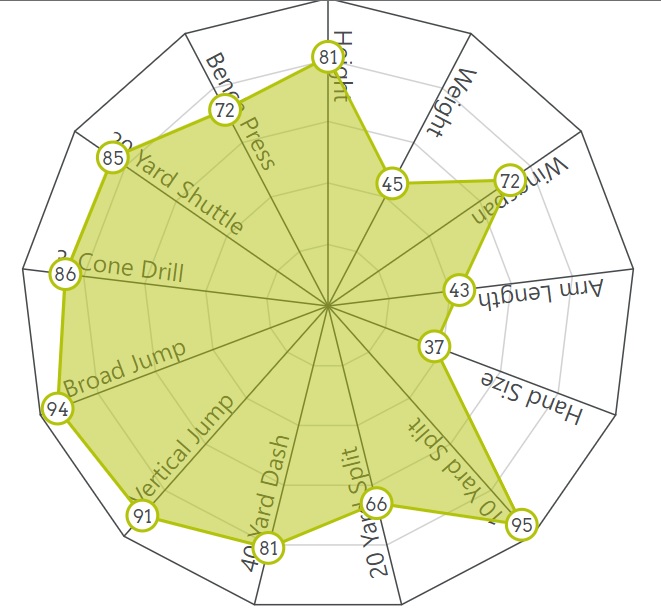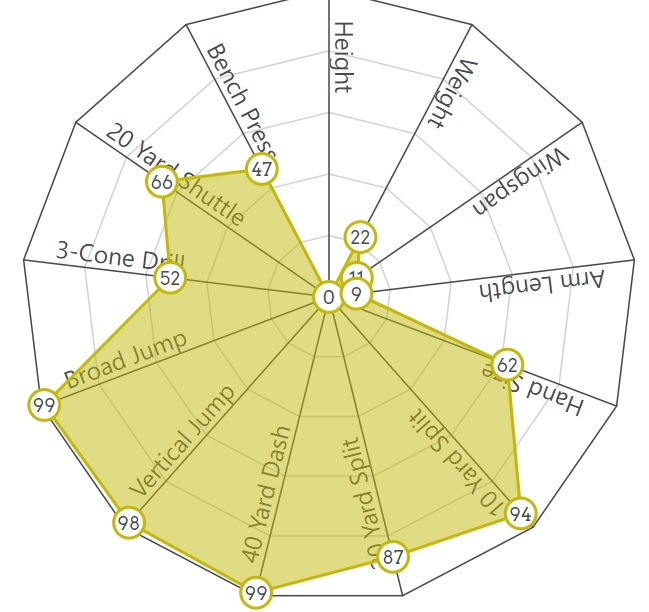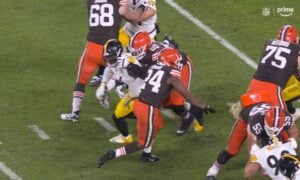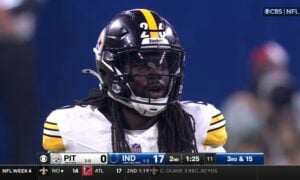I’ve been going down the athletic testing gleaned from the Pro Days and thought it might be interesting to share a few of the more important results at positions of particular interest. We looked at the top running backs the other day. Time to do the Centers.
Most of us will agree that center is one of the team’s top needs. I want to emphasize that this isn’t about a lack of faith in B.J. Finney. I remember his first tenure with the team quite well, and believe he has every chance of being a solid, mid-level starter in the league. But here’s the thing. I am a Steeler fan, not a follower of some scrub outfit with a twisted sense of O-Line priorities! The standard is the standard, and in Pittsburgh that standard is either one of the GOAT’s (Mike Webster or Dirt Dawson), or at least a viable HOF prospect like Pouncey. Finney is fine, but he ain’t on his way to the Hall of Fame, and an upgrade would ease my heart.
As luck would have it, the news on this front is nothing but good. We lost a few potential RB targets due to sub-Steelers-standard testing. The opposite is true here. We actually gained some.
REMINDER: Alex Kozora’s study on what the Steelers look for in IOL’s showed that Pittsburgh puts an extra heavy emphasis on good film, with no noticeable athletic pattern except good size. Colbert & Co. want solid, proven football players who top the 300 lb. mark with adequate length. Anyone under 300 better have a lot of room on his frame to pack on extra muscle; anyone shorter that 6’4″ should have extra long arms to compensate; and anyone with arms less than 32″ should have extra height to compensate in the other way. FWIW, normal practice expects guards to be a little bigger and longer than centers, but the bottom line is that film trumps measurements by an even bigger margin for IOL’s than is true for other positions.
Landon Dickerson, Alabama. Let’s not forget that Dickerson is the clear #1 center of this class on tape, and he blows away every physical standard there is. At 6055 and 333 lbs., with 33 1/4″ arms and no bad weight, he’d be a size XL guard and big enough to play tackle. For a center? He comes in darned close to being the largest man ever measured. Top 0.05%. I’d be leading the din for Dickerson at #24 with sword and spear in hand if not for the well-known medical red flags. Two season-ending ankle injuries in five years? Not good. Season ending ACL tears in two of the other three years? Frightening. The only season he finished was 2019.
And yet he’s still the consensus best center in the class on film despite so many missing games. The film, physique, and character are just that good.
No one will be surprised that Dickerson’s knee wasn’t up to a full workout at the Alabama Pro Day in early April, since his 2020 ACL surgery took place in December. Some might have worried about how well it went. After all, some players are never quite the same after tearing an ACL, and this was Dickerson’s second time. You may now put your mind at ease. No, he did not test at the Pro Day, but he still put on a show. Check out this clip where he video-bombs an interview with QB Mac Jones: Injured Landon Dickerson does cartwheels.
Turn the sound on and you’ll also hear Jones laughing about how Dickerson is also doing 400 lb. squats as part of his rehab. What can you say? Offensive linemen don’t do cartwheels in the first place! This guy is an alien that earthly freaks can only watch in awe.
I won’t tell anyone not to worry about all those injuries. I certainly do. But neither should we live in our fears, as a certain great coach once said. If the team doctors and trainers say, “Unlucky as hell but not injury prone,” Dickerson is the guy you want. End. Of. Story. If the doctors come back with, “It’s really a shame but…” or even “I won’t put my neck out either way,” his stock drops to Round 3-5, and maybe even worse. There is no in between unless you cut the difference mathematically. You and I have no real grounds for an opinion on his health. Hope or fear as your nature requires. Just recognize that all our opinions are more a matter of bias than judgment.
Creed Humphrey, Oklahoma. That was pretty impressive stuff from Landon Dickerson. How in the world can the number two center of the class compete? Well, Humphrey was at least healthy… so he went out and put up the best athletic profile ever recorded for any center in any year for which RAS has a record. His perfect 10.00 is also the single best athletic score of the 2021 class when measured across positions. O.M.Friggin’-G.
The most a naysayer can do is quibble that he barely met the Steeler thresholds at 6041 and 302 lbs. with 32 1/2″ arms. All passing grades but nothing special. That might matter if film and leadership weren’t the be-all and end-all of what you look for in a center. But they are, and Humphrey does almost as well in those areas too. NOTE: When you are “almost” the “best ever measured” at something, you don’t exactly suck. That wasn’t faint praise.
(Creed Humphrey MockDraftable Web)
Centers tend to fall in the draft, and so it has always been reasonable to hope that Humphrey would be there at #55. That could still happen despite the testing because of the talent distribution. The 2021 draft class has much more Round 1 talent on the offensive side of the ball, but seems to be heavy on defensive prospects (particularly edge rushers, ILB’s, and corners) from the late-first into the third.
Most of the teams that pick in front of Pittsburgh will be sorely tempted to go with an offensive pick in Round 1, which would be too early for Humphrey, and then to balance that with a defensive talent in Round 2, which would cause the top center to drop. The testing results have now confirmed what most of us thought going in: Creed Humphrey at #55 is definitely possible, and would be worth a TikTok happy dance if it happens.
THE NEXT TIER
That is the best 1-2 punch in my memory for the center position, bar none. But the wealth continues. There is a virtual dead heat for OC3 between two likable prospects. Which do you prefer? The all-around solid player from a football powerhouse, who has battled and practiced against elite competition? Or the draft sensation from a tiny school, who taught himself how to snap during the enforced COVID break, and then tossed around his Senior Bowl opponents like children?
Ohio State’s Josh Myers has faced a murderer’s row of defensive linemen in his two years as a starting center for one of the nation’s premier programs. He’s a safe and capable pick who will only improve with NFL coaching. His anchor against pure power is already good, he knows how to make line calls, and he has a few easy-to-fix technical holes that should make him even better during the early part of his career. E.g., he’s been vulnerable to really slippery opponents on passing downs, but better knee bend would fix that while also enhancing his movement skills.
Myers did no athletic testing so we only have the measurements. His 6051 height and 310 solid pounds exceed the Pittsburgh thresholds by a healthy amount, and 32″ arms are right there at the mark. Not at all bad for a center, especially with a really strong showing on the bench (29 reps).
So how can Quinn Meinerz of tiny Wisconsin-Whitewater possibly compete, especially when he’s never taken an actual snap at the position? There’s next to no way he could really contribute at center in his rookie year. What could possibly close that gap?
The first step would have to be a performance at the Senior Bowl so dominant that it had people laughing, and saying things like, “This is getting ridiculous!” Check. And he’d have to do that at both guard (his normal position) and center, to prove his versatility. Check.
Hmmm. Then he’d have to interview like a nigh-on-perfect young prospect. Check. There would have to be demonstrated interest from the Steelers. Check. And I would require an explanation of how he developed this sudden dominance during a year when he played no ball. Check.
Okay, that’s a lot of checks. So let’s look at the testing. There’s nothing wrong with Josh Myers, so Quinn Meinerz would have to be bloody awesome. Let’s try… 99.8th percentile overall. Check. A fairly tight 320 pounds. Check. Extra-long 33 3/8″ arms. Bam! Broad and vertical jumps in the 90+ percentile. Check. Also 90+ percentile as a runner, including a 99% over 20 yards. Check. Top 70% for the agility grades. Check.
The only “issue” is a lack of height (6027), which most pundits view as an advantage, not a problem, because it is easier for QBs to see over a shorter player. Height only matters if your length is suspect, and that isn’t the case with Quinn Meinerz. He tested as the #9 overall athlete of the year across all positions, and it would have been higher if the ranking system balanced height and length in a more realistic way.
(Quinn Meinerz MockDraftable Web)
So it comes down to personal preference. If you want to make the smart play, go with the perfectly adequate kid who has the film and experience to support his projected future. You’ll have someone that Gil Brandt put as his #42 player of the class, calling him, “A two-position player who I think can start for the next 8-9 years”. But if you want to gamble a bit on upside, with “solid guard” as the realistic floor, go with the HOF measurements of the Senior Bowl sensation. It’s entirely up to you.
THE BACKUP PLAN
The next tier consists of solid prospects with more obvious warts than than Myers, and a lot less upside than someone like Meinerz. All three are solid prospects who are good enough to consider “10-year career as a prized backup” as a failure, and to hope for eventual respect as a top-10 center in the league. The issues, as you’ll see, come down to some medical cautions in one case, and the risks inherent in moving from another OL position for the other two.
Trey Hill, Georgia. 6031, 319 lbs., with extremely long 33 5/8″ arms. Trey Hill has never been anything but solid as both a guard and a center, playing for one of the elite running attacks in all of college football. What he’s failed to do is wow anyone with his balance, agility, and pad level. It’s an issue that plagued him throughout 2020 and, according to Lance Zierlein’s highly critical NFL.com scouting profile, comes from a noticeable lack of consistent knee bend.
We now know that the knee bend issues had a physical cause. Hill toughed his way through 2020 on not one, but two knees that required meniscus surgery. That injury is pretty easy to fix — much easier than an ACL — but it also hurts like hell. So, in other words, he was playing through agony, and it showed. Lack of knee bend and poor pad level were repeated themes in Alex Kozora’s late January, gif-supported scouting report as well, but he was able to add that the surgeries were minor and reportedly went well. Alex ended with a solid Day 2 (Round 2-3) grade. And with all that depth above, we’re looking at something more like Round 3 or more likely 4 for the pick.
Can’t complain about that.
Kendrick Green, Illinois. Jonathan Heitritter’s gif-supported, late March scouting report describes a natural center who spent a lot of his time at guard, and will probably require a redshirt year in the NFL unless his team can accept blown plays as he learns the trade. That’s your downside. The upsides are a lot more numerous. He plays a smart-man’s game as an OL, with excellent burst at the snap and fluid mobility, plus a real knack for getting his body between the defender and the play. He’s better at run blocking than pass protection, and could add more nastiness to his game, but there’s also room to grow as a technician.
The athletic testing, like that of Quinn Meinerz, went amazingly well in every area but height. He came in at 6017 and 305 lbs., with 32 1/4″ arms. Meinerz was a little heftier and a little longer, but they’re still easy to compare. The charts say it all. He comes in as a Top 8-9% IOL athlete whose only flaws are in the areas related to length. The highs and lows are pretty extreme!
(Kendrick Green MockDraftable Web)
NOTE: Green may be a player that the Steelers could screen out due to lack of size. As noted above, that is the one characteristic that seemed to matter according to Alex’s number crunching.
Robert Hainsey, Notre Dame. Look to the Depot for more about this native son of the Burgh! This April article by Dave Bryan examines the many dots that can be connected between Hainsey and his hometown team. Jonathan Heitritter’s gif-supported April scouting report summed him up as, “a smart player that has maximized his abilities [and] can play multiple positions, but is lacking in physical tools and upside.” Those question marks may have been answered by the athletic testing.
Hainsey was a college tackle who survived as a smart, overachieving player with great hand fighting skills, both for punching and for gripping. He was just too short to project as someone who could pull off the same trick against NFL athletes, even though he tested out as a surprisingly good, top 20% athlete on the scale of NFL tackles. The deficits in height, arm length, and wingspan are just too big to ignore, though he could prove the world wrong like Kelvin Beachum did.
Change the standard to IOL’s and poof! You have a top 8-9% athlete instead. The actual measurements are 6046, 306 lbs. with 32 1/4” arms; all comfortably above the Steeler thresholds. And at worst he projects as a valuable depth piece who can be your backup at all five OL positions. That in itself has a lot of value. If only he could learn to long-snap…
After those three you get to the “break glass in case of emergency” prospects, who are also better than what you see in a lot of other years. I won’t go into any details but the names to keep an eye on are:
- Michael Menet, Penn State. Solid, safe, and experienced, but suffering from a minor case of T-Rex syndrome with 31 1/2” arms, and he is just an average athlete. High floor, low ceiling.
- Jimmy Morrissey, Pitt. The great overachiever who tested as a top-10% athlete but has not shown that kind of athleticism on film. Nor anything close according to Alex Kozora’s gif-supported scouting report. Met all the size and length standards, so he is a viable alternative if other players trump the need at center until later in Day 3.
- Drew Dalmon, Stanford. He tested as a top-2% athlete, but he is slightly undersized at 6033 and 299 lbs., with 32” arms. Usually projected as a fit for outside zone teams rather than the mixed gap/power/inside zone approach favored by Pittsburgh.
Call them players who project as solid backups with starter potential, and you won’t be far from the truth.
CONCLUSION
This seems to be the distribution we’re looking at:
- Round 1 (or avoid). Landon Dickerson.
- Early 2nd. Creed Humphrey. A bargain at #55.
- Fringe 2nd to Early 3rd. Josh Myers and Quinn Meinerz. Viable at #55, bargains at #88.
- Round 3-4. Trey Hill, Kendrick Green, and Robert Hainsey.
- Round 6. Michael Menet, Jimmy Morrissey, and Drew Dalman.
It is a pretty strong class with fine prospects at every tier, including Round 1 if you wash away Dickerson’s medical concerns. I have to believe that the 2021 draft will offer Pittsburgh multiple opportunities to strengthen the center position. The question will be whether each of those chances offers a bargain that is even bigger than the options at some other position. If Dickerson is healthy, is he a better Round 1 pick than a RB like Najee Harris or Travis Etienne, or a Tackle like Teven Jenkins? Will a defensive steal or a likely OT gain the value edge over someone like Creed Humphrey? Will Myers or Meinerz be available in Round 3, and would center be the target if the team went after some pair like an OT and RB with the first two picks?
It will be fun to find out.

